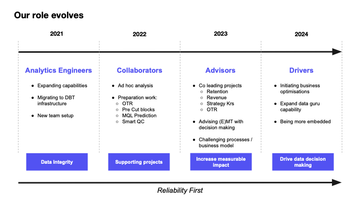Are we approaching a value crisis?
[Recap] Over the last few months I’ve been speaking to data leaders to glean as much wisdom as possible, and package that into this newsletter. This has come in the form of formalized interviews, informal events, and quick chats over coffee. I am nearing 100 of these data conversations, and as such I thought I’d try something different with this article - instead of sharing the wisdom of others, I want to share a pattern I’m noticing after all these conversations about our teams, and see if it’s something other people have been noticing too.
This newsletter is brought to you by the team at Count. Count is a data whiteboard making analytics and data modeling collaborative, transparent, and trusted. Learn morehere.
[Note] Due to the sensitive nature of this article, I’ve chosen to keep all references to speakers and companies anonymous.
I’ve been hearing a familiar conversation among data leaders lately:
DATA LEADER 1We’re about to implement [self-service tool A], so any advice you all have on that is welcome.
DATA LEADER 2Oh we are just moving off of [self-service tool A] - it really didn’t work for our stakeholders. We’re just switching over to [self-service tool B].
DATA LEADER 3Yeah we’ve found [self-service tool A] lacking so we’re playing with some LLM stuff now.
ALL DATA LEADERS NOD IN VIOLENT AGREEMENT
Up to now, this conversation didn’t strike me as odd or particularly interesting, but last week when I witnessed it again, it was accompanied by a new sense of uneasiness.
A shifting tide
To understand this, I must first step back.
A few weeks ago, someone I previously interviewed for this series emailed me and told me their whole data team had been let go. This leader, whose team I considered to be one of the most mature, and well-managed data teams I worked with, had seen their entire department wiped in a day.
Things like this happen occasionally, but this is not the only instance of a data team getting cut recently. This is now the third story I’ve heard of a data team getting cut in the last 30 days, not to mention two others who were significantly reduced.
Furthermore, a colleague of mine who hosts a data podcast told me how many of his guests (business leaders not data leaders) are asking him whether the last decade of ‘data’ has been more hype than substance - and whether they should continue to fund data teams to the same level they have been.
And yes, this is anecdotal evidence. I don’t believe there’s an impending wave of companies getting rid of their data teams completely, but I also don’t believe this meansnothing.
In an environment more cost-focused than we’ve seen in a long time, the value of the data team is coming into question more and more often.

What is valuable?
The teams I know of that were cut or significantly reduced were all centralized data teams that primarily operated as enablers.
Their core responsibilities were to create and maintain the data model, serve key reports and dashboards to the wider company, and provide a way for people to serve up their insights.
While that’s never been my preferred setup for a data team, I recognized its value.
But what if that’s no longer enough? What if in the face of cost-cutting and an environment where we are no longer the only ones serving up insights, having a team that manages a data model no one sees, a drag-and-drop chart builder and a few dashboards isn’t worth the money? Or more likely, it isn’t worth the cost of the Modern Data Stack we’ve all built to run that set-up.
I posed this question a few nights ago to a few data leaders. Most were quick to say I was overreacting:
“Maybe there are things we could do better, but they’ll always need the infrastructure support, they’ll always need the modeling and standardization we provide.”
But is that true? Hadn’t these companies who had cut their data teams chosen a different path - one in which they get their insights without our standardization and infrastructure? Or with a least a much-reduced version of it.
One data leader agreed:
“The biggest risk I see is that data teams become IT teams. And IT teams aren’t driving the business, they aren’t big players. No one wants to be there. And if we keep focusing all our time on behind-the-scenes stuff, we could be in trouble.”
What does this have to do with self-service?
So why was this conversation on self-service tools leaving me so nervous?
Over the last few years, many data teams have undergone a huge back-end transformation in their stacks. They have standardized how data goes from source tool to data warehouse. They have set up dbt, and with it, have created models and robust testing suites that ensure the data that’s consumed is clean and reliable.
Most teams needed to take a huge step back from their typical operations to undergo this transformation. They had to agree to slower delivery times, fewer projects, and increased costs - but all in pursuit of a worthy goal. A healthy backend would mean everyone would benefit later. Everyone would have cleaner data, and they’d be able to get their insights more quickly.
However, I see teams getting stuck in an endless pursuit of a perfectly efficient and performant back end. We lose sight of the fact that getting your stack in order was onlystep 1of a big transformation - not the end goal.
“I totally feel that endless pursuit of perfection with no clear end goal - constantly changing goalposts.”
Self-service analyticsfeels like an extension of that same way of thinking. Teams are on the same dogged pursuit of a capability rather than asking what would be the most valuable thing.
In short, it’s not about graduating from a modeling tool to a self-service tool, it’s about growing from enablers to drivers.

What does it look like to focus on value?
A more constructive way to look at this problem was to ask myself who seemed to be in the best shape - which teams I know seemed to be best able to articulate why they should exist, and why they should operate the way they do.
This came down to a combination of:
- Structure
- Leadership
Case Study 1: A European fintech holding data teams to account
One leader I spoke to recently talked me through a re-org her team had undergone recently that had done the following:
- reduced the analytics team to 2 people who largely support operational reporting
- moved the data engineering team to report to the technology department
- and created a new decision science team, full of data scientists and decisions scientists, the latter working directly with the business
The last change is by far the most significant. By having key business objectives they are responsible for, the team better understands the wider business and how their work can make positive impacts.
Case Study 2: A centralized team with influence
Not everyone can have an entire team dedicated to a few single metrics like that, so another company has taken a leaner approach.
This data team is a small centralized group but has recruited data gurus with the wider business teams that remain in the business units. These data gurus are the ones working to make sure data is driving business value. This could sound like another service-orientated data team, but the difference is the centralized data team takes a very active approach tohowthese data gurus do their jobs.
They evaluate the data gurus, and their departments to work out how well they are driving value with data, and work to coach both leaders within these departments and the gurus themselves to make sure that happens.
Case Study 3: A hybrid-embedded team co-delivering value
Being close to the business is a surefire way to make sure a data team is driving value.
The most common way we see that is with hybrid-embedded data teams, like one company whose Product Analytics team is very closely integrated with the wider Product team.
The product analysts are part of each product team. They are accountable to the product goals and deliverables and feel empowered to do their part to make sure they reach them.
Case Study 4: A team for the big, hairy problems
Lastly, one team I spoke to had a research branch of their data team that was responsible for tackling some of the company’s biggest, messiest problems (e.g. How to engage users?). By creating a team in charge of those big problems, and by successfully addressing some of those problems, their value was evident and felt by the wider organization.
Creating even a small team that is responsible for driving value can be a powerful way to change the discussion around your data team.
Where do we go from here?
So my first question isDo you agree?I can believe I’m seeing only a subset of the data. If you see something else, I’d love to know!
We will be focusing on this topic over the next few weeks (assuming it’s notallin my head) including sharing playbooks of teams that have made small interventions to help them be more value-driven (and less service-driven), some thematic discussions on things like the impact of team structure on a data team’s ability to generate value, and the leadership qualities required to lead a team out of being a service team.
If you have any topics or questions you want us to cover, please drop us a comment below!